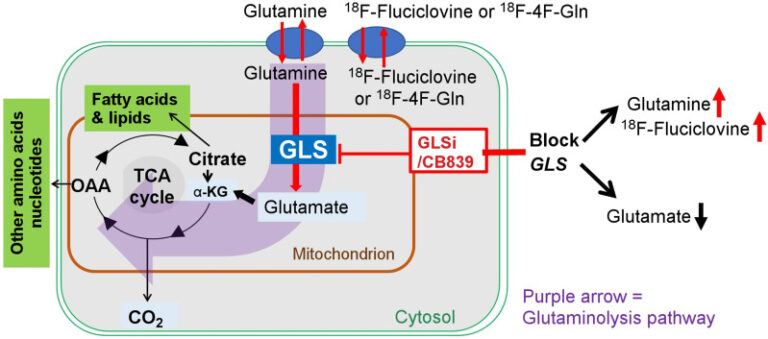18F-Fluciclovine PET Imaging of Glutaminase Inhibition in Breast Cancer Models
In this study by Zhou et al., the B-cube (PET) was used as an in-vivo, non-invasive tool to longitudinally investigate the response of an 18F-glutamine-analogue to inhibition of breast cancer metabolism. The CUBES allowed researchers to visualize and demonstrate the use of 18F-Fluciclovine PET as a pharmacodynamic marker for drug development for an oncology drug via dynamic imaging.
Research question
Aggressive cancers such as triple-negative breast cancer (TNBC) avidly metabolize glutamine as a feature of their malignant phenotype. The conversion of glutamine to glutamate by the glutaminase (GLS) enzyme represents the first and rate-limiting step of this pathway and, therefore, could be a target for drug development. A novel GLS inhibitor (GLSi) has been developed and tested in clinical trials but with limited success, suggesting the potential for a biomarker to select patients who could benefit from this novel therapy. This study aims to examine a non-metabolized amino acid analog, 18F-Fluciclovine (Axumin®), as a PET imaging biomarker for detecting the pharmacodynamic response to GLSi.

Experiment
Mice bearing TNBC (HCC38, HCC1806 and MBAMD-231) and estrogen receptor (ER)-positive (MCF-7) breast cancer xenografts were imaged with dynamic PET at baseline and after a 2-day treatment of GLSi (CB839 (Telaglenastat)) or vehicle. Kinetic analysis suggested reversible tracer uptake and the distribution volume of 18F-Fluciclovine was estimated by Logan plot analysis.
Results
A significant increase in distribution volume was observed after GLSi (CB839) treatment in TNBC models exhibiting high GLS activity (HCC38 and HCC1806) but not in TNBC or MCF-7 exhibiting low GLS. Changes in distribution volume were corroborated with changes in GLS activity measured in CB839- versus vehicle-treated tumors, as well as with changes in distribution volume of [ 18F]-(2S,R4)-fluoroglutamine was previously validated as a measure of cellular glutamine pool size. A moderate, albeit significant, decrease of [18F]fluorodeoxyglucose PET signal was observed in HCC1806 tumors after CB839 treatment.
The study shows that 18F-Fluciclovine is taken up in breast cancer cells via glutamine transporters and is not metabolized; thus, 18F-Fluciclovine can track and assess glutamine pool size. 18F-Fluciclovine PET marker might provide information that can help select patients for treatment targeting glutamine metabolism, such as glutaminase inhibitors. In conclusion, 18F-Fluciclovine PET has the potential to serve as a clinically translatable, pharmacodynamic biomarker of GLSi (such as CB839).
